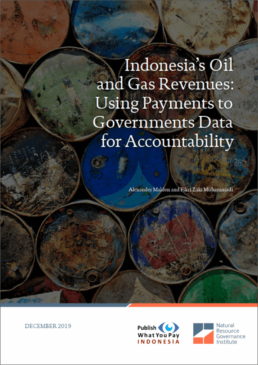The oil and gas sector is a significant source of revenue for the Indonesian government, contributing 7.4 percent of government revenue in 2018. Yet, a sharp decline in oil and gas revenues in 2015 has seen fundamental changes occur in the country’s oil and gas sector in recent years. Specifically, in 2017, the government announced it was moving away from the cost recovery PSC model that had been in place for over 50 years.
It shifted governance of Indonesia’s oil and gas sector to a gross split PSC model, meaning the government’s share of production from a project will, in future agreements, be based on the project’s gross revenue, rather than the profit it generates. In 2018, the government removed the upper limit of $250 million on the value of signature bonuses when awarding a new PSC. Recently, there has also been increasing public debate on how to improve the governance of the distribution of revenues generated from the oil and gas sector. This discussion has led to the government’s effort to increase the amount that it generates from the oil and gas sector and to improve the management and allocation of the resulting revenue.
This report demonstrates ways that accountability actors, including civil society, government, media and official oversight actors can use newly released Payment to Government (PtG) data to hold companies and government entities accountable for the revenues generated from oil and gas projects in the country. In this report, we explore what this data can tell us about the country’s oil and gas sector. We also look at what other extractives data sources oversight actors can incorporate into analysis of the sector.
Mandatory disclosure laws in the European Union, Canada and Norway require companies listed or incorporated in these jurisdictions are required to disclose the payments they make to government entities for their extractive activities. These newly released PtG reports supply timely information on the payments oil, gas and mining companies make to Indonesian government entities for their extractive activities. Companies must categorize payments into one of seven payment types, such as taxes or royalties They must also report which government entity receives the payments and must break down the payments by project, where applicable.
Seventeen international oil and gas companies have disclosed over $15 billion in payments to Indonesian government entities since 2014 under these laws. In 2018, both the largest oil producer, Chevron, and the largest gas producer BP, disclosed $3.3 billion and $987 million in payments to Indonesian government entities, respectively.
The first section of this report provides an overview of Indonesia’s oil and gas sector, the recent developments that have occurred and national debates on the governance of the sector. The second section shows how civil society, media, government, EITI and official oversight actors can access and use PtG data to analyze the country’s oil and gas sector. The remaining three sections of the report outline ways in which oversight actors can use this data as an accountability tool in Indonesia. These sections explore how accountability actors can use PtG data to verify the size and recipient(s) of oil and gas project signature bonuses and how to estimate and verify the revenue that local and regional government entities should receive from an oil and gas project operating in their region. It also details how to estimate and verify the government’s share of production from a project under the new gross split PSC model.

Author:
Alexander Malden and Fikri Zaki Muhammadi
Publisher:
NRGI Indonesia
Download: Format PDF – Google Drive